You love houseplants, but don’t know which flower to buy first? Or maybe you already have your own collection of indoor plants and want to add something exotic to it?
The choice of exotic indoor plants today is very large. Any flower shop can already boast a great variety of such miracle plants as orchid or money tree, or lemon, and even pomegranate. Housewives have also learned to care for such exotic plants in our conditions.
So, if you have decided to purchase a tropical foreigner, then we suggest you get acquainted with the most popular plants and find out in what conditions they need to be kept so that they not only grow, but also bear fruit. We present to you the 7 most popular exotic indoor plants.
First up is the lemon tree.
It is the lemon tree that lovers of exotic indoor plants most often dream of purchasing. Lemon is a perennial citrus plant that can also be grown at home. At proper care this plant can bloom twice a year and produce a harvest of 10 to 60 lemons. It is very interesting to grow a whole tree from a seed. A lemon grown in an apartment can reach a height of 1.5 meters.
Within two to three years, some species of this exotic plant begin to bear fruit. Lemon trees must be placed in places where there is no direct sunlight, only diffused light, and be sure to place it in a slightly cool room, in which the air temperature will be from +10 C to +23 C. A lemon tree requires frequent watering, but under no circumstances do not over-water it. For irrigation, only settled water at room temperature is used.
This tropical plant will grow and bear fruit well in a room with high humidity. Tree loves Fresh air, therefore in summer period It is best to keep it on the balcony or terrace.
In second place is the banana tree.
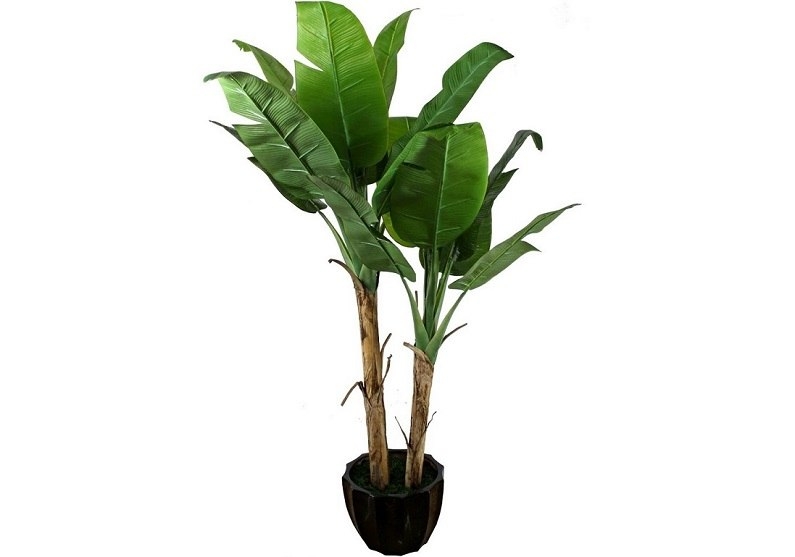
This tropical palm tree will certainly add unusualness and exoticism to your interior. Besides large sizes it will not reach it, since breeders have already developed varieties of this tree suitable for growing in apartments. The banana tree is a cold-resistant indoor plant, so it can be kept in a room with an air temperature of +15 C to 30 C. Also, this plant will bear fruit better in a room with high humidity. The banana tree should not be overdried. If a lump of earth dries out, it must be immediately watered abundantly, otherwise the tree may dry out.
In third place is the date palm.

In good home conditions and with proper maintenance, this plant can grow up to 2 meters in height. The ideal place for a date palm would be partial shade. Direct sunlight is contraindicated; it will simply destroy the plant. This tropical plant also loves high humidity and abundant watering, although in winter it is necessary to water it a little less often than in spring and summer. The palm tree does not tolerate heat well; it needs a temperature regime of no less than +15 C and no higher than +20 C.
In fourth place is indoor feijoa.
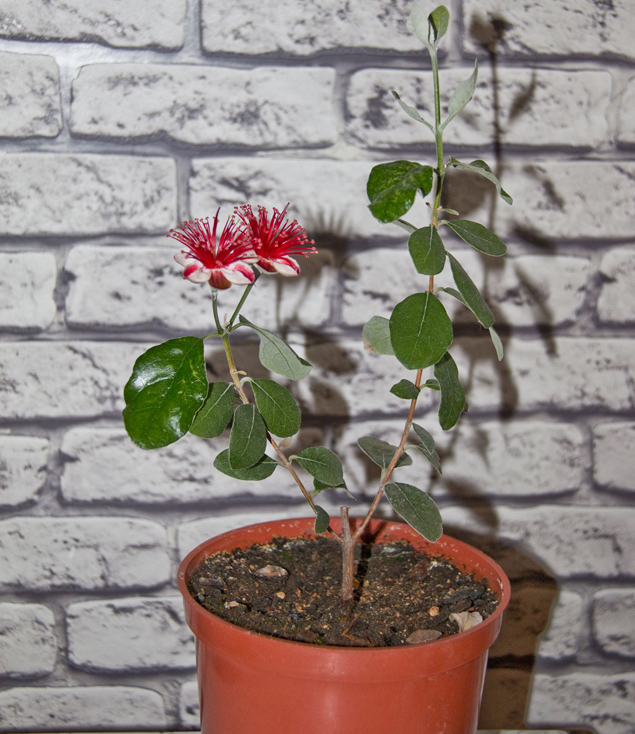
This plant can now live in your apartment, because breeders have developed a self-pollinating species. Indoor feijoa will actively grow and bear fruit only in a room with high humidity and subject to abundant watering. If the plant dries out even a little, it will almost immediately shed its leaves and stop growing. Feijoas should be placed in a relatively warm, but not hot room, with plenty of light. Feijoa does not tolerate heat, so this plant must be kept at a temperature not lower than +12 C and not higher than +22 C.
In fifth place is eucalyptus.

This is one of the unpretentious exotic indoor plants that requires virtually no special care, and also has healing properties, which is why this plant is very popular among gardeners. Eucalyptus needs a lot of light, it can even be placed in a sunny place. This plant should be watered moderately and only when the soil dries out. Air humidity is not important for home eucalyptus, the main thing is that the air temperature does not fall below +10C. With proper maintenance, eucalyptus can delight you with new fragrant green leaves and beautiful flowers in early spring.
In sixth place is the tea tree.
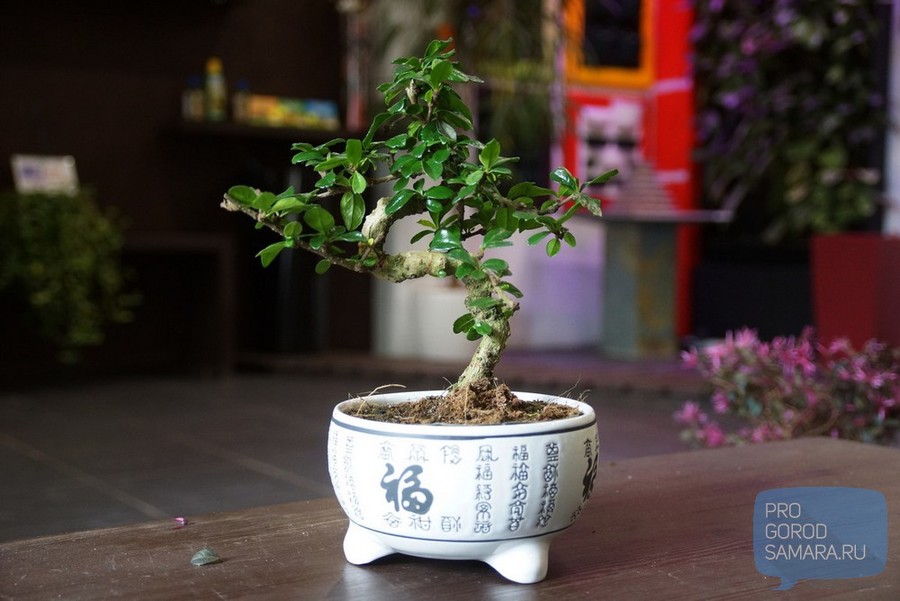
This exotic plant is ideal for growing at home. It, like eucalyptus, is unpretentious, and also has a lot of medicinal properties. But at the same time, gardeners can also drink tea from a couple of freshly picked leaves of this plant. Growing a tea tree bush in an apartment is not difficult; it is enough to water it generously with settled water at room temperature and place it in a room with high humidity. To obtain a high-quality harvest, you need to spray the tea tree leaves at least twice a week. This plant is heat-loving and moisture-loving, therefore, if the temperature exceeds +20C, it is worth increasing watering.
And in seventh place is the olive tree.
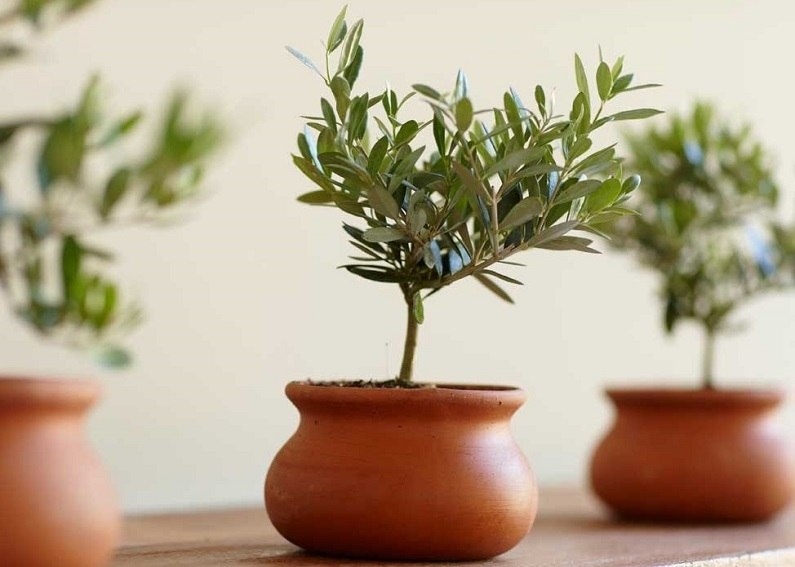
This exotic indoor plant breaks all records for harvesting at home, but this is only with proper and proper care. Ideally, you can harvest 2 kilograms of olives from an olive tree grown in an apartment. This plant is placed in a sunny place. To avoid stagnation of water after watering, the olive tree must be planted in good drainage soil. For active growth and fruiting, the olive tree needs warmth, but not heat, so the plant is kept at an air temperature of no lower than +15C and no higher than +30C.
Enjoy the wonderful world of bright and incredibly charming exotic and tropical plants and be convinced of their unpretentiousness and ease of maintenance.
Today, the choice of plants in any flower shop is captivating with its variety, which is why a violet, orchid or money tree today will no longer surprise anyone. At home, exotic plants such as pomegranate, lemon or banana trees are increasingly found.
Let's look at the most popular such plants and find out what kind of care they need for active growth and fruiting.
Lemon Tree
The lemon tree can easily be called the most popular exotic indoor plant; many gardeners have been able to harvest at least one harvest of lemons. On average, with proper care of this plant, you can get a harvest of 10-60 pieces, it all depends on the variety of homemade lemon and the age of the plant.
Most species begin to bear fruit in 2-3 years; the main feature of this plant is that it can form a bud, bloom, bear fruit and ripen all year round, while some fruits are still hanging on the tree and ripening, many buds are just beginning to open.
The lemon tree prefers a large amount of diffused light, temperatures within +18-+23 degrees, in winter it is advisable to find a cooler room for this plant, where the temperature will be +10-+13 degrees. You need to water the plant often, but moderately; it is advisable not to overdry the earthen ball, but also not to flood it.
Be sure to use settled water at room temperature for watering; once every two days, the flowerpot should be sprayed with a spray bottle and the leaves should be wiped with a damp cloth. It is advisable to maintain it in the room where this tree grows high level air humidity.
In summer, it is best to take the plant out onto balconies and terraces; this tree needs fresh air.
banana tree
For connoisseurs of exotic indoor plants, breeders have developed several varieties of banana trees, which are fully adapted for growth and fruiting in city apartments. Let's start with the fact that almost all types of indoor bananas are cold-resistant; they develop equally quickly at temperatures of +15 and +32 degrees. This plant is also capable of absorbing moisture from the environment, so it is advisable to maintain a high level of humidity in the room where the banana grows.
At low humidity and high temperature The banana tree should be sprayed daily with a spray bottle and watered abundantly. As soon as the earthen lump has dried, the container with the banana tree is placed in a pan of water for 15-20 minutes, as a rule, during this time the plant has time to “get drunk” required quantity water and wait for the next watering. In the summer, it is advisable to help the plant with fertilizing and fertilizers, which are applied once every 3-4 weeks.
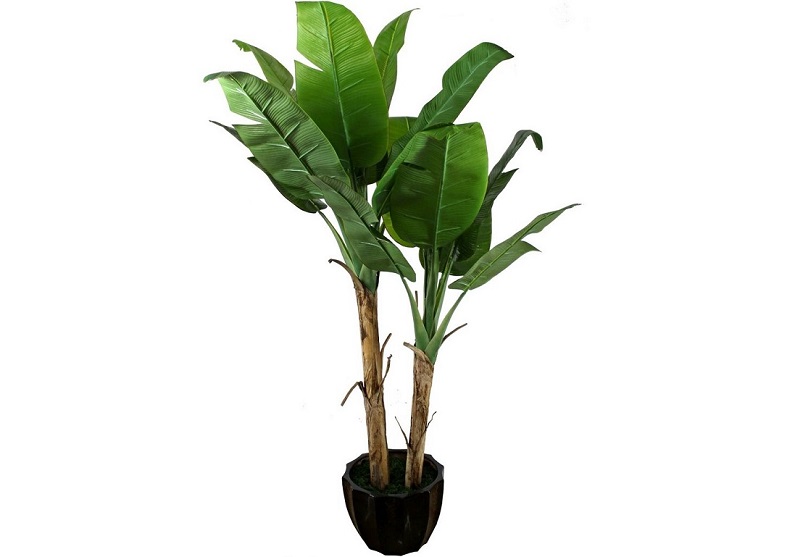
Date palm
This plant, even at home, can grow up to 1.5-2 meters in height; thanks to this size, the date palm is used for zoning large rooms. Those who want to grow a date palm at home need to provide it suitable care, first of all, you should find a suitable place; partial shade is ideal, but direct sunlight is contraindicated for this plant.
The decorative properties of this plant appear at 5-6 years; at the very beginning, the palm tree looks rather unsightly. The date palm needs to be watered abundantly, especially in spring and summer, and watering can be reduced in winter.
Optimal temperature for this exotic plant +15-+20 degrees, it is especially difficult to maintain such a temperature regime in the summer, because if your apartment does not have air conditioning, then this plant will have a hard time.
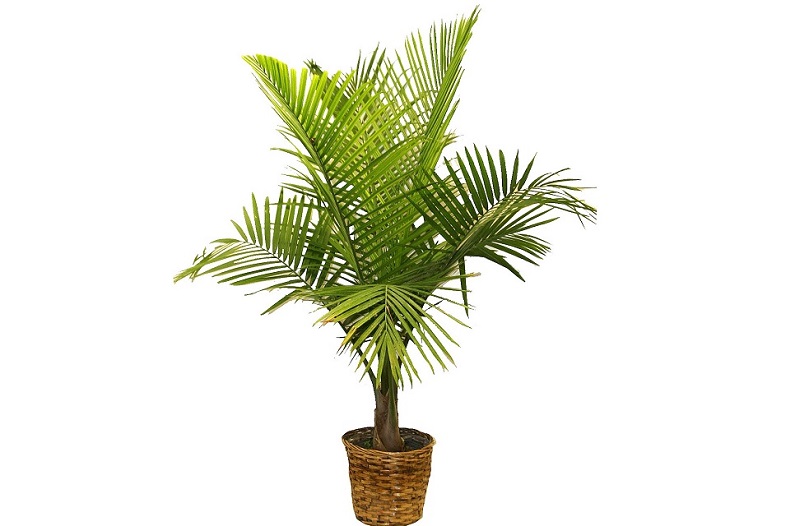
Indoor feijoa
Today, growing indoor feijoa has become possible only thanks to self-pollinating species, which breeders have recently bred. Temperature conditions in summer should be within +19-+22 degrees, and in winter the temperature can even drop to +12, but feijoa does not tolerate excessive heat.
A necessary attribute for active growth and fruiting is high air humidity in the room where the plant is located. Indoor feijoas need to be watered very generously; as soon as the earthen ball dries out and the plant feels a lack of moisture, it will immediately shed its leaves and stop development. The planting site must be chosen with the expectation that this plant is light-loving in autumn and needs large quantities diffused light.
Eucalyptus
Among many other exotic houseplants, indoor eucalyptus is an easy-to-care plant, starting with the fact that it easily adapts to room temperature. It is desirable that it be above +10 degrees. Also, this plant is not picky about indoor air humidity; the only thing that is vital for home eucalyptus is an abundance of light, even direct sunlight and moderate watering, which is done as the soil dries.
Thanks to your medicinal properties, the eucalyptus plant is incredibly popular among gardeners and, with proper care, not only pleases with its green, fragrant leaves, but also with flowers that appear in early spring.

Tea tree
It would be redundant to describe everything healing properties, which the leaves of the tea bush possess, but imagine that this exotic plant can be grown at home without much hassle and, if desired, throw a couple of fresh petals into your tea. To grow a tea tree bush at home, it will be enough to regularly water the plant generously with settled warm water, spray the tea tree leaves at least twice a week, and also ensure high air humidity in the room where this flowerpot lives.
The optimal temperature in the apartment should be within +12-+20 , if the thermometer mark rises higher, then you should increase the amount of water for irrigation and constantly spray the flower with a spray bottle.
Olive Tree
This may come as a surprise to many, but at home with proper care you can get a harvest of 2 kg of olives. When growing an olive tree in an apartment, you need to provide this plant with a sufficient amount of sunlight, preferably diffused, non-acidic soil, a good drainage layer that will help avoid stagnation of water and regular abundant watering. The permissible room temperature can range from +15 to +30 degrees.
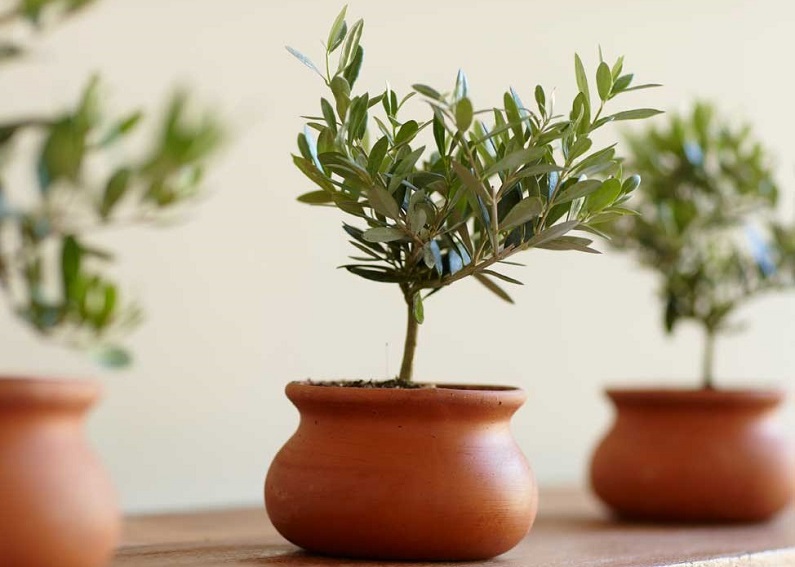
To print
Yulia Pyatkova 04/25/2016 | 10676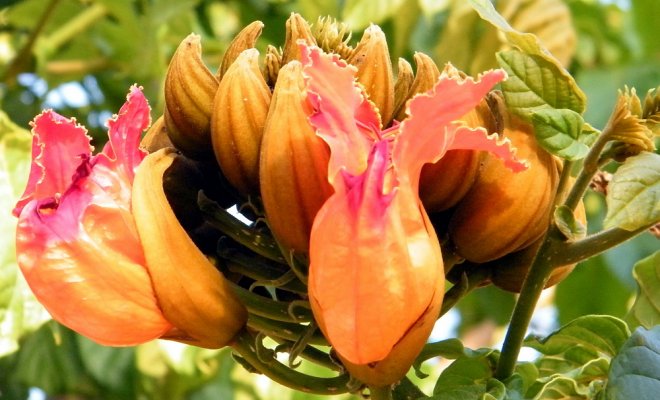
Do you want your window sill to attract the attention of guests and passers-by? Get exotic plants.
If you love everything unusual and exclusive, you will definitely love our selection of indoor plants.
1. Kennedyia nigra
The flowers of this vine are very rare, almost black. They are small in size (up to 4 cm in diameter), but bloom profusely and for a long time. If you decide to get a Kennedy, keep in mind that when good care it grows strongly (the length of the lashes can be up to 6 m).

2. Velvichia
This plant is perhaps the strangest on our planet. It consists of 2 long leaves sticking out of the ground (under natural conditions their length can reach 4 m). It is very easy to grow Velvichia at home. The plant is completely undemanding to soil. It is enough to keep it warm and water it occasionally.
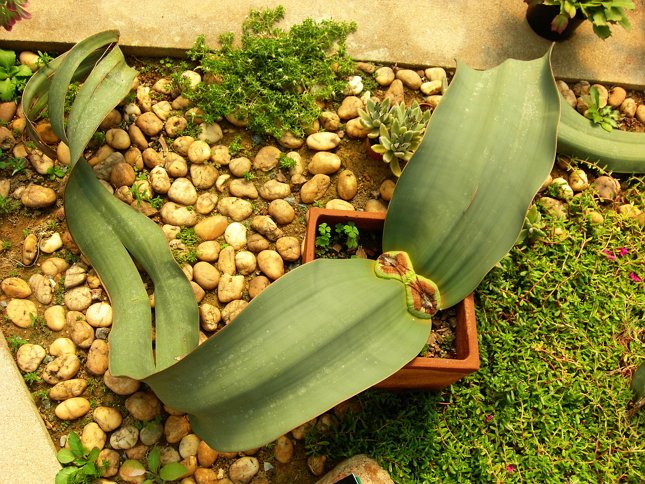
3. Macadamia
“Diamond nut,” as this plant is also called, belongs to the Proteaceae family. Macadamia is found mainly in Australia, Brazil and Hawaii. In natural conditions, it is a tree that can reach 15 m in height. But you can grow this crop as a house plant. It is especially prized for its decorative foliage, which creates an Australian style indoors. Macadamia feels good in winter gardens and greenhouses. The white and pink flowers of the plant are quite original: the buds bloom on a long inflorescence. The fruits of the plant are nuts.
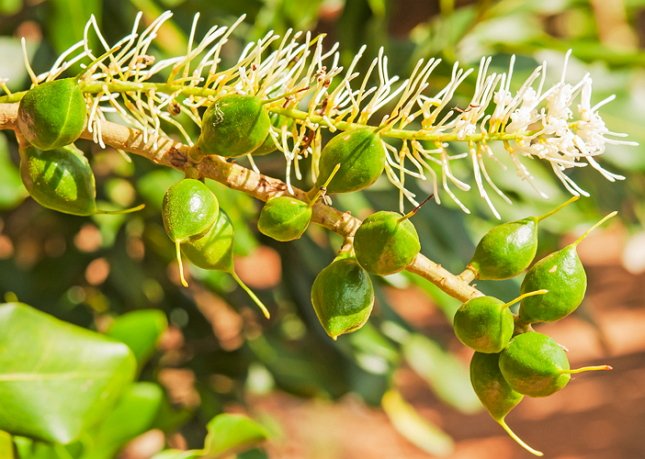
4. Sarracenia
This culture will certainly appeal to those who love carnivorous plants. Sarracenia is a herbaceous perennial that is native to North America. The peculiarity of the flower is that from time to time it feeds on insects. However, unlike the Venus flytrap or sundew, which is better known to gardeners, sarracenia does not slam its trap. Insects that fly into the “cup” of a predator simply drown in the viscous and sticky liquid inside. This is a truly unusual plant that will become a striking example of an exotic flower garden collection.

5. Bauhinia
A tropical orchid tree called Bauhinia will certainly interest all orchid lovers. And although these plants are not relatives, they are still similar in one thing - magnificent flowering. At home, Bauhinia is a small tree with delicate pale pink flowers. The shape of the buds of the tropical guest resembles orchid flowers, for which the plant received its second name - orchid tree. But bauhinia does not bloom for long: the flowers bloom in the morning and last for about a day.

6. Takka
The peculiarity, of course, is in its incredible flowers, reminiscent in shape and color bat. This effect is secured by long peduncles (up to 25 cm), which, with a weak breeze, set the flowers in motion. The plant is not too big, but definitely impressive. At home, it usually grows up to 40 cm in height. In nature, takka is a very tenacious crop that can live in various natural conditions and on different soils. Therefore, this tropical plant can be easily adapted to indoor conditions.
Exotic indoor plants can become an unusual decoration for your home. Let's look at the most popular plants.
This is a close relative of the well-known money tree, but geometrically amazing correct form. It forms an erect, square column with fleshy, pressed, raised leaves. Several of these columns in one pot, planted close to each other, look very nice. They grow calmly vertically upwards, then they can collapse from their own weight.
The main thing in caring for this crassula is to quickly replant it from shipping peat into light soil mixed with sand 1 to 1, place it in a well-lit place and do not flood it - it is very drought-resistant. In general, this plant is very hardy, although it grows slowly.
It blooms with a “cap” of small white or pinkish flowers at the top, and the buds are usually red.
It can produce “babies” from the base or branch.
You need a small pot, and if a fairly large container is used for decorative purposes, most of it is filled with stones.
This crassula is propagated by cuttings (for example, side shoots) or leaves.
The cutting, completely covered with leaves, is placed vertically on barely damp sand, and if there is a bare section of the stem, it is dried (again vertically) for up to 2 weeks and then planted in the same way, deepening to the first leaves.
The leaves are dried for 1 - 2 days and rooted in a mixture of earth and sand in equal parts.
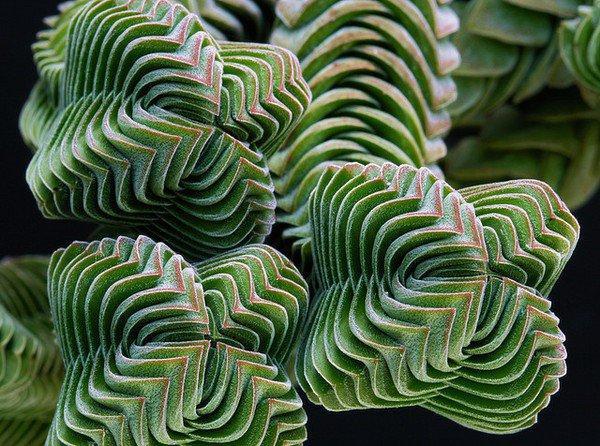
Dionea (Venus flytrap, Dione's mousetrap)
This (up to 25 cm tall) plant from North America belongs to the sundew family. In nature, it grows in sphagnum bogs, where there is a minimum of nutrients in the soil, so it had to adapt to obtain nutrients from insects.
At the end of each leaf there is a bivalve trap up to 15 cm in diameter with rather long teeth. The upper side of the opened trap is red and emits a pleasant sweet aroma. It is equipped with six receptor hairs that “switch” when touched again, and the trap slams shut. It takes 7-12 days for the victim to be digested, but if there was a “false alarm”, the trap will open within a day.
Triggering the trap each time requires a lot of energy, so do not overuse this “pampering”. After several digestion cycles, the trap dies and is replaced by a young one.
The lighting should be bright, but diffused. Western and eastern window sills that receive direct sunlight for at least 4 hours a day, in the morning or evening, are suitable. Due to lack of lighting, the leaves become thin and stretched, and the traps lose their red color.
Air humidity should be at least 40%, and better – 70 – 90%. To do this, use a tray with expanded clay and water and a layer of moss on the surface of the pot. Dionaea feels best in a glass container - a greenhouse, terrarium or the like.
The optimal temperature is +13 - +20 0 C, but +4 - +27 0 C is allowed. Moreover, for the winter you can put the plant in a dark, cool room, but you can also leave it in the living room with additional lighting with fluorescent lamps.
The amount of watering corresponds to the temperature and phase of plant development: in summer, the pot is immersed in warm water every 3 days, and during cold, dark wintering, watering is carried out only in the pan, and very rarely - approximately once every 4 - 6 weeks.
If the flies do not fall into the traps themselves, you can “toss” them every 2 weeks - but only alive, so that they move. This completely replaces traditional fertilizing, but even without such food the plant can survive for up to 2 - 3 months. A sick, damaged, newly transplanted or other plant after stress should not be fed.
Conventional mineral and organic fertilizers are prohibited - they will burn tender roots.
Transplantation is needed once every 2–3 years, in March, in a deep pot.
The soil is poor, acidic, light; from peat, sand, or with the addition of sand and moss. Adding regular soil is not recommended.
In winter, the above-ground part of the plant may die off - this is normal; in the spring it will be reborn, because enough nutrients are stored in the bulbs on the roots.
The Venus flytrap propagates by dividing the rhizome (in July, at least one bulb, cut at an angle), leaf cuttings (torn out with a piece of rhizome when transplanting) or seeds.
Root divisions and cuttings are planted in a mixture of peat and perlite under a glass cover.
Seeds can be germinated simply on a flat surface under a film in good light for 15 - 17 hours a day - in about 3 weeks. You can sow them in peat in the fall and also cover them with film or glass, but then they will germinate only by February.
Diseases and pests rarely affect this plant, but when moisture stagnates and low temperatures, gray rot or sooty fungus can develop - then spray with fungicides. Pests that may be seen include aphids, spider mites, mealybugs or fungus gnats.
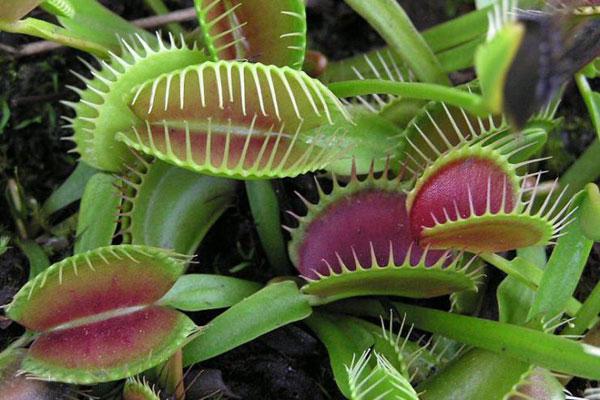
Albuka Spiralina is a very original plant that even a novice gardener can handle, but it is still very rare. It is a succulent from the Asparagus family, native to the deserts of southern Africa.
It is original with its leaves - first 25 - 28 dense, fleshy, flattened “arrows” appear, and then they begin to curl strongly in spirals, like curls after curlers. Moreover, they rise no higher than 16 cm above ground level, and in length, if you try to unfold them, they can reach 34 cm.
The flowering of this plant is also interesting: 10–20 flowers appear on a peduncle up to 60 cm, arranged like a lily of the valley. The flowers themselves are fragrant greenish or yellow, with a green perianth of 6 leaves, 3 of which “hug” the flower, and another 3 are bent to the sides.
There is a variety with a small dense bright yellow fluffy inflorescence surrounded by a wide wreath of white flat elongated bracts arranged in one row.
This plant is bulbous, “wakes up” in the fall, leaves grow all winter, and flowering begins in April. In summer, the above-ground part dies off, and in the fall, before new periods of growth, the bulb is transplanted into fresh soil.
You can buy the substrate for succulents or prepare it yourself, adding more coarse-grained quartz sand.
Curling leaves are the result of hot, dry weather with very bright light, try to create such conditions on your windowsill, and this plant will thank you with its original beauty.
Water the albuca rarely, just so that the soil does not dry out completely. During the dormant period, the bulb is not moistened at all.
This flower prefers a cool temperature, +7 - +18 0 C, especially during the periods when growth begins and buds begin to form.
Lighting throughout the entire period of active growth should be maximum.
Albuca propagates by seeds or children from a bulb, but seedlings will bloom in the 3rd year, and children - already in the 1st year.

It is interesting for its flowers, which bloom in spring and last up to 1.5 months, and in open ground- from June until the first frost. The flower is velvety, consists of two “bubbles” - lips, and the lower one is usually much larger than the upper one, can reach 6 - 10 cm, and up to 55 flowers can bloom on one plant. Color varies: white, bright yellow, orange, red, burgundy or purple background, often with red, burgundy or pink dots or strokes.
The plant is perennial by nature, but in cultivation it is usually grown as an annual, in a cool room or in open ground.
Varieties of hybrid calceolaria are usually grown in the room - different in color, but with the same flower shape, reminiscent of a pot-bellied purse, with a large oval horizontal lower lip, up to 6 cm.
In open ground, Calceolaria Fothercilla (Uniflora) is very popular with very original flowers: the lower lip is long, up to 10 cm, trapezoidal or almost square, closed about half, reminiscent of a drooping jaw. The color is orange, with a burgundy “chin” and a white wide horizontal stripe along the outer edge of the lip. Upper lip about 5 times smaller, hangs like a visor over the crop, has a blurred red spot on the outside.
Also in the flower beds you can find Tripartite, Two-flowered and Wrinkled Calcellaria with smaller monochromatic yellow flowers. The latter blooms the longest.
The main condition for long and successful flowering of calceolaria is a temperature of +12 - +16 0 C, because at +20 0 C buds and flowers can already fall off.
Watering is needed very abundantly, on average 2 times a week.
Air humidity should be high, but calceolaria does not like spraying.
The lighting is bright but diffuse. East and west windows.
Fertilizing - with complex universal mineral fertilizer, every 1 - 2 weeks.
You can try to grow indoor calceolaria in a perennial culture; to do this, after flowering, they are cut off and put away for 1.5 - 2 months in a cool (+8 - +12 0 C) bright place, until new shoots begin to grow. In winter, it is advisable to provide additional light to these plants so that they do not stretch out.
But it is better to buy or sow a new plant every year. The seeds are very small; in June or March (for autumn flowering) they are scattered on the surface of the peat and covered with glass. After about 2 weeks, at a temperature of about +18 0, shoots appear and the temperature is reduced by 3 - 4 degrees; when there are 2 true leaves, the seedlings dive, and when a rosette of leaves is formed, the top is pinched and the flower is transplanted to a permanent place. Crops and tender seedlings are moistened only by spraying from a very fine spray bottle.
Calceolaria is often attacked by aphids and whiteflies, so spray it regularly with insecticides, but not more than once every 2 weeks.
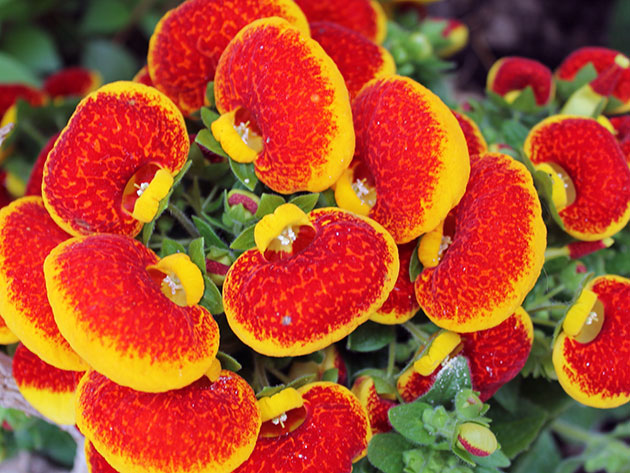
These are quite famous exotic flowers that evoke associations with the Caribbean islands and exoticism. They are often called Frangipani - after the name of the perfumer who actively used their spicy citrus-jasmine aroma.
In fact, this is a tree or bush, which in nature reaches 5m, and in a room - up to 2m. It comes from Central and South America and blooms all summer, filling the room with a wonderful aroma in the morning.
The “classic” plumeria flower is white and yellow: each petal, snow-white at the end, gradually becomes bright yellow towards the middle. The petals are oval, slightly pointed, collected in corollas of 5 pieces. The inflorescence-scutellum unites 15 - 20 flowers about 5 cm, less often - up to 10 cm in diameter.
The flowers also look original because the pistil and stamens are not visible - they are short, about 1 mm, hidden in a recess in the center of the flower.
In general, there may be more or less yellow color, and pink tones can also be added (Plumeria tricolor is very impressive) or the main tone may not be white, but from soft pink to fuchsia. Often the petals are slightly curled at the edges, or the entire flower is “twisted”, like an eustoma (buds) or like a propeller (open flowers).
The leaves are oblong, quite large (up to 10x40cm), green, similar to the leaves of white-veined milkweed.
The lighting should be bright enough; the plumeria should be exposed to direct sunlight for at least 6 hours a day. However, on a hot summer afternoon it is better to shade it slightly. If there is a lack of light, it will not bloom.
The temperature in summer is around +25 0 C, acceptable is +20 - +30 0 C. In winter, the temperature is reduced to +14 - +17 0 C.
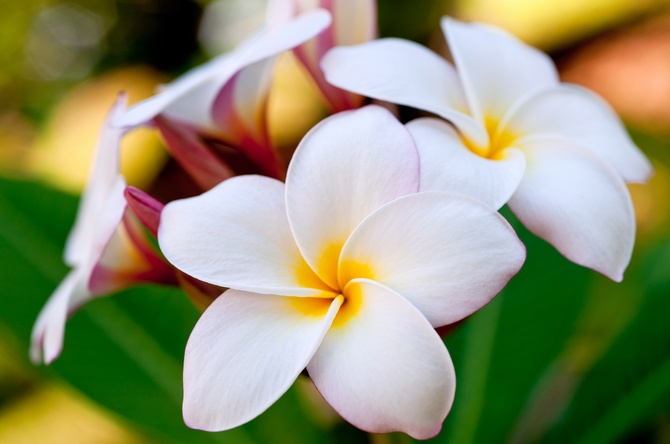
Watering directly depends on the temperature and stage of plant development: in summer, during the flowering period, it is very abundant.
Air humidity should be high, but when spraying it is undesirable to get water on the inflorescences.
Young plumerias are replanted annually, in March; the soil is chosen to be nutritious.
In winter, frangipani has a dormant period of 3 - 6 weeks, during which the old leaves usually fall off.
Plumeria milk juice is poisonous - avoid contact with skin and mucous membranes, and also make sure that this plant is inaccessible to pets. But due to its toxicity, plumeria is not eaten by pests - only occasionally can a spider mite be seen.
This plant is propagated by cuttings - at least 20 cm long and 2 - 5 cm in diameter, which are cut at an angle, washed of juice and rooted in a warm greenhouse with light soil.
Seed propagation is also possible, but it does not guarantee the preservation of all varietal characteristics of the parent plant, and seedlings will bloom only for 2–3 years.
Every passionate gardener dreams of adding exotic indoor plants to their collection. If earlier we had well-known geraniums and sansevierias on our windows, and tradescantia hanging from the shelves, now a huge number of unusual exotic plants have hit our flower market.
In crop production as well as in everything else modern world There is a certain fashion, and our flower market fully corresponds to it. Now you can buy plants to suit any, even the most sophisticated taste. The flowers are striking in their shape, size and color. Flowering plants bloom with huge flowers 25-30 cm (hibiscus, brugmansia). And decorative deciduous plants can surprise us with the size, shape and color of their foliage.
There are plants with unusual properties, for example, predatory flowers, the bashful mimosa, which, when touched, folds and lowers its leaves. Moreover, she does it so quickly that it seems as if it is not a plant, but a living creature from a fairy-tale world.
Plants in our home are not just decoration. They clean the air in the room, create humidity, have a functional purpose, and also bring joy and good mood. 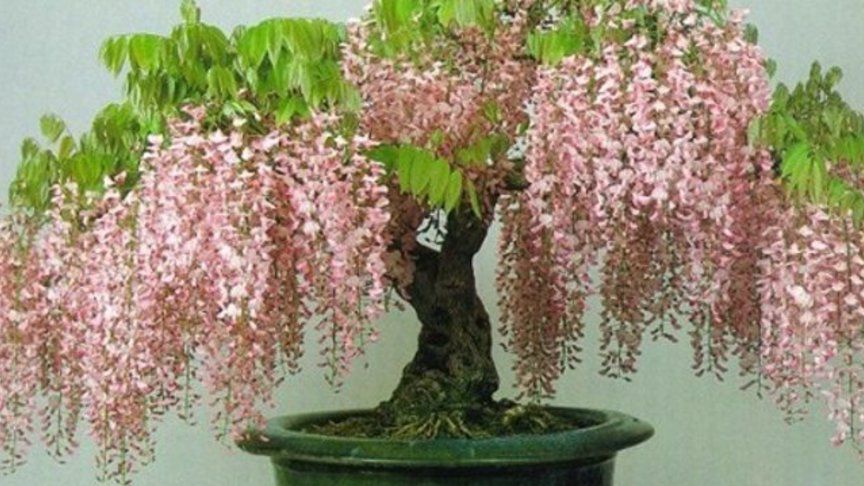
Exotic indoor plants on our windowsills are no longer surprising. Indoor pineapple, figs, avocados, and tamarillos are very common and in demand.
We must not forget that when purchasing or planting seeds of exotic plants, certain rules must be followed. The soil needs to be sterilized, you can pour boiling water on it. When the seedlings sprout, place them in a lighted place, as well as provide warmth without drafts and humidity. The same conditions must be provided for adult plants when purchased in stores or from collectors. When growing exotic plants, you need to be more patient and careful. They came to us from the tropics or subtropics, where 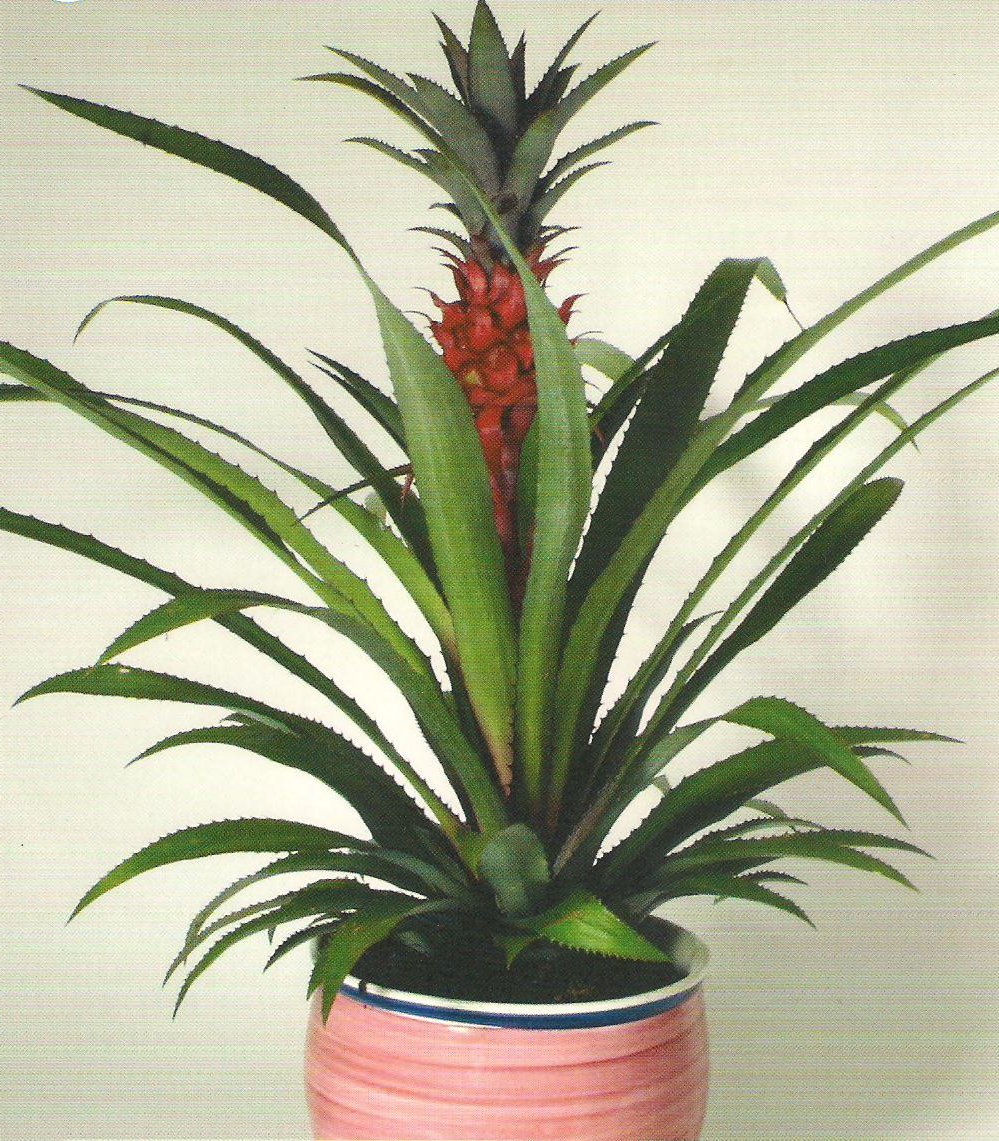 cool, warm climate. Our task is to create a microclimate close to the natural environment.
cool, warm climate. Our task is to create a microclimate close to the natural environment.
Exotic plants are fashionable and original. You will be able to delight and surprise your acquaintances and friends.









